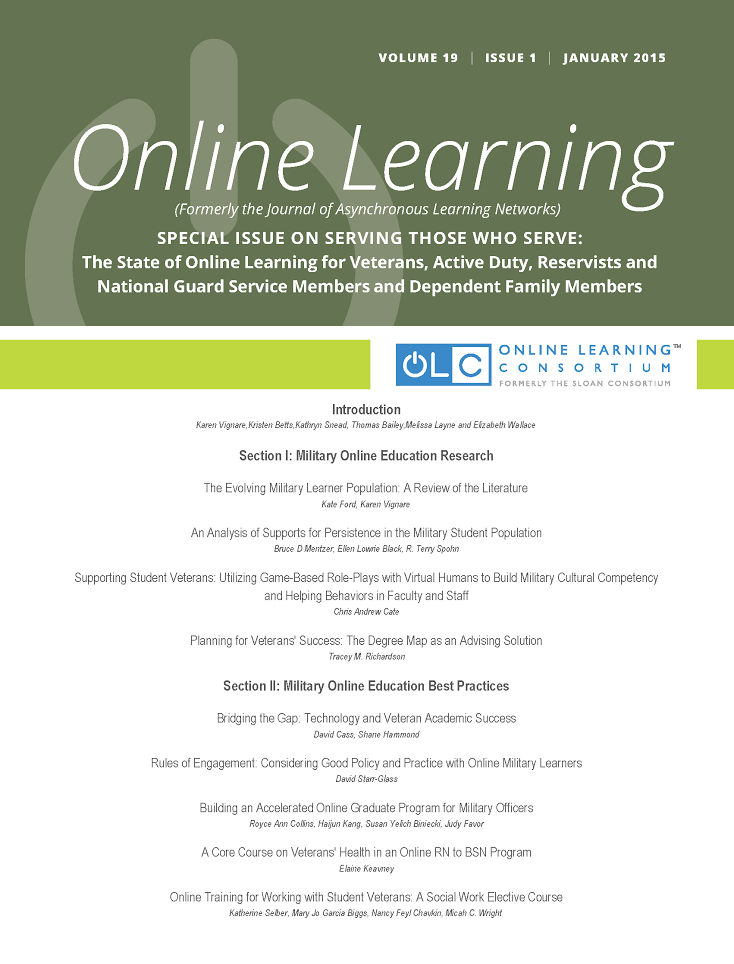Planning for Veterans' Success! The Degree Map as an Advising Solution
DOI:
https://doi.org/10.24059/olj.v19i1.494Keywords:
Veterans’ success, academic advising, degree planningAbstract
Due of the expected influx of veterans attending college, it is critical that higher education not only be cognizant of the projected growth, but take a proactive stand and properly plan for these students’ success. Academic planning begins with the advising professionals developing open communications and be able to guide veteran students through the matriculation process. The purpose of this mixed method study is to explore the potential impact of degree maps on facilitating veteran students’ success. This study’s findings suggest the degree map is a powerful tool to help students through class selection and sequencing. The results provide insight into the similarities and differences between military, veteran, and civilian adult students’ needs. The degree map data provides transparency that will contribute to institutional and governmental monitoring for ongoing outreach to student veterans.References
Ackerman, R., & DiRamio, D. (Eds.). (2009). Creating a Veteran-Friendly Campus: Strategies
for Transition and Success: New Directions for Student Services,| (No. 126). John Wiley & Sons.
Ackerman R. and DiRamio, D. (2011). Creating a veteran-friendly campus: Strategies for
transition and success: New directions for student services, number 126. New York: John Wiley & Sons.
Ackerman, R., DiRamio, D., & Garza Mitchell, R. L. (2009). Transitions: Combat veterans as
college students. New directions for student services, (126) 5-14.
American Council on Education (2012, July 25). Many colleges and universities ramping up
programs for military and veteran students. Retrieved From http://www.acenet.edu/news-room/Pages/Soldier-to-Student-II.aspx
Church, T.E., (2009). Returning veterans on campus with War-related injuries and the long road
back Home. Journal of postsecondary education and disability, 22(1), 43-52.
Creswell, J. W. (2012). Education Research: Planning, conducting, and evaluating quantitative
and qualitative research design. Pearson. Boston, MA. Publications,
Creswell, J. W., & Clark, V. L. P. (2007). Designing and conducting mixed methods research.
Sage Publications, Inc. Thousand Oaks, CA.
Department of Defense. (2014). Third party education assessment: Final assessment report
Embry-Riddle Aeronautical University.
Grossman, P. (July 2009). Foreword with a challenge: Leading our campuses away from the
perfect storm. Journal of postsecondary education and disability, 22(1), 07- 13.
Lang, W. A., Harriett, B. D., & Cadet, M. (2013). Completing the Mission II: A study of veteran
students’ progress toward degree attainment in the Post 9/11 Era. Retrieved from http://www.operationpromiseforservicemembers.com/Completing_Mission_II.pdf
Lokken, J. M., Pfeffer, D. S., McAuley, J., & Strong, C. (2009). A Statewide approach to
creating veteran-friendly campuses. New Directions for Student Services, (126), 45-54.
Persky, K. R., & Oliver, D. E. (2011). Veterans coming home to the community college:
Linking research to practice. Community College Journal of Research and Practice, 35(1-2), 111–120.
Project Management Institute Global Accreditation Center. (2013). On-site and evaluation report
for MSPM at Embry-Riddle Aeronautical University. Newtown Square, PA.
U. S. Department of Veterans Affairs. (2013). Veterans Benefit Administration. Retrieved
from http://apscu.org/news-and-media/sectornews/upload/VA_Transparency_Report_4_15_13.pdf
United States Department of Veterans’ Affairs (USDVA), (2012) U.S. Department of Veteran
http://www.benefits.va.gov/REPORTS/abr/2012_abr.pdf
http://www.gibill.va.gov/benefits/post_911_gibill/index.htmlReferences
Vacchi, D. T. (2012). Considering student veterans on the twenty-first century college campus.
About Campus, 17(2), 15-21.
Vance, M., & Miller, W. (2009). Serving wounded warriors: Current practices in postsecondary
education. Journal of postsecondary education and disability, 22(1), 18-35.
Zinger, L., & Cohen, A. (2010). Veterans returning from war into the classroom: How can
colleges be better prepared to meet their needs? Contemporary Issues in Education Research, 3:1, 39-51.
Downloads
Published
Issue
Section
License
As a condition of publication, the author agrees to apply the Creative Commons – Attribution International 4.0 (CC-BY) License to OLJ articles. See: https://creativecommons.org/licenses/by/4.0/.
This licence allows anyone to reproduce OLJ articles at no cost and without further permission as long as they attribute the author and the journal. This permission includes printing, sharing and other forms of distribution.
Author(s) hold copyright in their work, and retain publishing rights without restrictions






